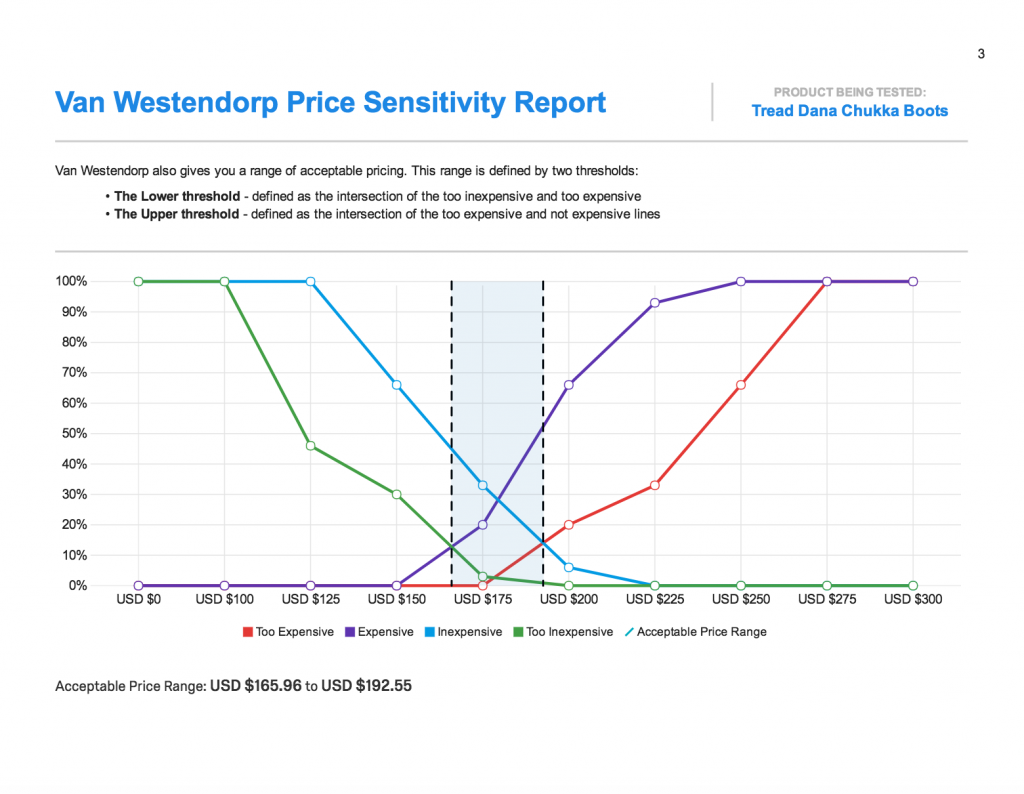
Addressing pricing in market research is one of the most trickiest areas to cover. Those who ask direct pricing questions will almost always get flawed data.
If you ask a customer, “How much are you willing to pay for this Widget?” They will almost always low ball or underbid. It almost becomes a game among survey participants where they believe they can get a “deal” or trick the sponsoring company managing the survey to lower the cost of the product or service.
It’s no way to accurately address the price in a survey. You cannot ask directly.
Other less formal options include a tiered pricing strategy. This is where you ask the likelihood to purchase the product at several flat price points.
In the survey, you start with the highest potential price point and ask the respondent “How likely would you be to purchase this Widget for $300?” Then you work your way down from $300, to $250 and $200.
Through this feedback, you can understand where a large portion of your customers will no longer purchase the Widget. However, this is also an inexact science. Although less flawed than asking for an open-ended price, it does still have several limitations.
Looking for a way to address the price of your product or service in your survey?
Think about using the van Westendorp pricing model.
One of the more popular ways to address pricing in surveys over the years in the market research industry is by using the van Westendorp price sensitivity model.
The van Wessen what? It’s okay, we got you covered.
This model works if you are interested in finalizing a price for a new product or service, better understanding of competitive pricing, or assessing how the price will impact the demand for your products or services.
Whatever the case may be, here is some more information on what the van Westendorp model is and how it works in your survey.
What is the van Westendorp Pricing Model?
Developed in the mid-1970s, this model addresses the proper value or price of a product or service through a series of 4 survey questions. It is often called the Price Sensitivity Meter (PSM).
The model can be used to examine a variety of price points under consideration. It can help a company understand the impact of price changes as well as competitive price changes.
All your van Westendorp questions answered in one blog.
How does the van Westendorp Pricing Model work?
The model uses 4 direct questions asked to survey participants. These questions can be used in your online survey, email survey, mail survey, or phone survey.
It asks the following 4 questions. If your company offers services instead of products, you can easily swap out the language.
- At what price do you think the product is priced so low that it makes you question its quality?
- At what price do you think the product is a bargain?
- At what price do you think the product begins to seem expensive?
- At what price do you think the product is too expensive?
You have two options as far as answers for respondents. You can leave each question open-ended and let the respondent write in the dollar value for each, or you can provide them a range of price points. Essentially open-ended versus closed-ended questions.
We recommend offering a range of price points for your survey respondents. The reason for this points to one of our early points in this post. When asked open-ended, respondents may write or type in unrealistic price points which then become outliers or unusable data.
By dictating the high and low ranges of price points to select it adds to the control of this test. If you know you cannot produce your product for less than $16 per unit then how usable is 20% of your respondents writing in prices of $16 or less?
Once you have the price data, what’s next?
After receiving the survey data, the next step of the van Westendorp pricing model is to plot the data points for each of the 4 questions.
Each of the 4 colored lines below in the example from Qualtrics corresponds to 1 of the 4 pricing sensitivity model questions (doubt quality, cheap, expensive, too expensive).

Once these are plotted using 4 separate lines on the line chart, the next step is to pay attention to the intersections in the data.
The optimum price point (OPP) is the price where the same number of respondents reported the product as doubting the quality and being too expensive ($18.50).
The indifference price point (IPP) is where the same number of respondents reported the product being a bargain and expensive ($20.00).
The range of acceptable prices extends from the “marginal cheapness” to the “marginal expensiveness”. In this case, those intersections range from $17.00 to $24.00. When pricing your product you do not want to veer beyond this range and most likely aim to price the product at the OPP.
What are the limitations of the van Westendorp model?
The van Westendorp model is thorough but it takes significant time to cover in a survey. In many cases, the approach is a little too complex for small and mid-size businesses and clients. It’s also not the most engaging series of questions for a respondent.
Addressing solely the price in the survey does have his limitations as well. Without knowing product features or benefits the respondent may find it difficult to assign not only 1 but choose 4 price points for the asked questions. It attempts to address value without any context.
We always recommend including at least 1 open-ended question after asking the van Westendorp series. If anything, it gives the survey analyst some additional feedback and context to review when analyzing the price points chosen by each respondent.
Are there other options to address pricing in a survey?
One of the more successful pricing approaches I’ve used in prior market research was conjoint.
Conjoint analysis assesses price but it is delivered to the respondent in a package including other product features and benefits.
Conjoint addresses price without having to single it out separately.
An example of simple conjoint would be asking a respondent to pick from one of the following 2 product packages:
Package 1
- Overnight shipping
- 1-year product warranty
- 3-year customer support plan
- $199
Package 2
- 2-day shipping
- 2-year product warranty
- 2-year customer support plan
- $159
As you can see in the simple conjoint, price is addressed but it is packaged into other product benefits to assign value.
As enough of these packages are asked to respondents the survey analyst can begin to isolate and understand the incremental value of each offering (e.g. respondents are willing to pay $19 for 1 additional year of product warranty).
Contact our Market Research Firm
Understanding the pros and cons of all pricing options and approaches for your market research is essential. The chosen approach needs to consider a number of factors from the market research firm’s suggestion, to client preference, to respondent tolerance.
Drive Research is an expert market research firm. Interested in conducting pricing market research for your next product or service?
Get a quote with us today using the button below or send us an email at [email protected].



